Latest update 14 January 200
Below you will find an overview of the particulars of the different types of helmets in the USAAF/USAF P-series. Many helmets deviate from these particulars either through different production standards (especially true for P-1 and P-1A helmet) or modifications. More information about each individual type can be found using the menu to the left.
P-1
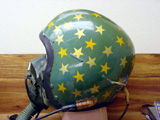
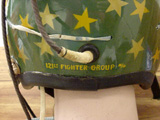
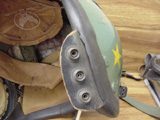
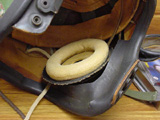
Far left: The original P-1 may be
identified by its black rubber edge beading, black leather oxygen mask tabs, lack
of chin and napestrap, and no external earphone attachment features. The black edge
beading is not enough in
itself to identify a P-1 as some P-1A helmets had them as well. Left:
Close-up of the rear showing the lack of nape
strap. Right: The P-1 had black leather oxygen mask tabs which protruded
through the black rubber edge beading.
Another identifying feature is the white print saying "Army Air Forces" on the
internal leather crown pad. After the
USAAF became USAF in 1947 helmets were ordered with the text "US Air Forces" or
"US Air Force". Far right: The
headset in the P-1 was attached to the helmet by routing the strap suspension assembly
nylon cord through a hole
in the top of the earpad. The bottom of the earpad was only kept in place by being tucked
in behind the broad
section of the rubber edge beading. The earpad has been pulled out a bit in this picture.
Pictures © Milehigh
P-1A
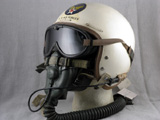
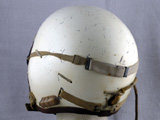
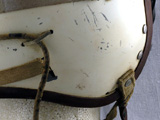
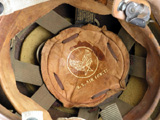
Far left: The P-1A is identified by its
tan- or cream-coloured rubber edge beading - the colour varying depending
on the manufacturer and the amount of UV light the beading has been exposed to. Left:
The P-1A was the first
P-series helmet featuring factory-installed chin and nape straps and rubber boot covering
the female microphone
plug on the left side of the helmet shell. Right: The HS-38A headset
earpads in the P-1A were secured at the bot-
tom by a thin nylon cord routed through two holes in the helmet shell. The cord is visible
immediately behind the
chin strap. Far right: P-1A strap suspension assembly with "U.S. Air
Forces" print. Pictures © Bluelight
P-1B
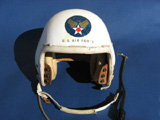
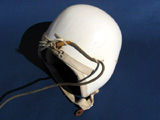
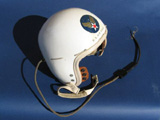
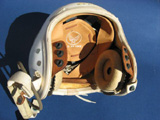
Far left: The P-1B helmet is impossible to
distinguish from a late P-1A without looking at the manufacturer's paper
label inside the helmet shell. Left: Seen from this angle the angular
appearance of the size small helmet is clearly
visible. Right: P-1B helmets and late P-1A helmets had three dimples set
in a triangular pattern on each temple.
They indicate where the visor attachment plates should be installed in case of
modification with a fixed visor. Try to
compare with the early P-1A above. Far right: Compared to the P-1A above,
this factory-fresh helmet shows the
colour variation between an old weathered edge beading and a new one. This particular edge
beading is atypical by
being made of cast rubber instead of the standard extruded rubber. Pictures © unknown
P-2
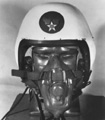
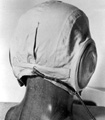
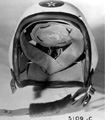
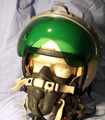
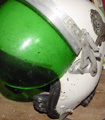
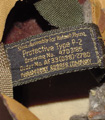
Far left, Left, and Middle
left: The P-2 helmet is a very rare bird indeed; in fact it is so rare that
no-one knows
exactly what it looks like. One school of thought holds the view that it was this
two-piece experimental helmet with
separate inner liner and outer hardshell, following the same principles as the US Navy H-3
and H-4 helmets. Middle
right, Right and Far right: Others are of the opinion that the
P-2 was the first P-helmet type fitted with a fixed
visor. The helmet sling is clearly marked P-2 but there is no guarantee that it has not
been retrofitted to this parti-
cular helmet. Pictures © USAF and Bones
P-3
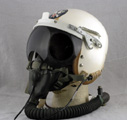
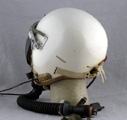
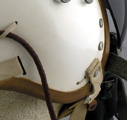
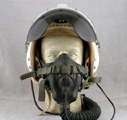
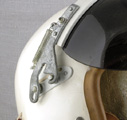
Far left: The P-3 helmet was the first of
the P-series that was factory-made with a fixed visor. The visors changed
slightly in appearance over the years but the P-3 visor is easy to recognize by its square
metal flange protruding
upwards on the visor yoke. Left: Apart from the fixed visor, the P-3
helmet configuration is just like the P-1A.
Middle: The headset is attached in the same way as on the P-1A, hence the
two holes and the nylon cord behind
the chin strap. Right: Compared to later visors the P-3 visor is
characteristic by hanging down into the pilot's field
of view. Far right: The reason for the hanging visor is the short J-arms
that prevent the visor yoke from moving
further upwards and backwards. Pictures © Bluelight
P-4
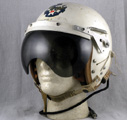
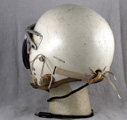
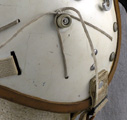
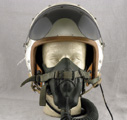
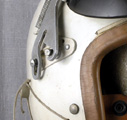
Far left: One of the obvious differences
between the P-3 and P-4 visors is that the latter does not have the square
metal flange on the visor yoke (there is one exception to this rule - early P-4 helmets
made by Bassons Industries
Corporation had the same type of visor as the P-3). Left: The P-4 helmet
was fitted with a new, low impedance
headset, the H-75/AIC, that featured a more bulky rubber boot for the female microphone
plug on the left side of
the helmet. Middle: A close-up view of the new headset attachment screws
and drawstring secured over a rubber
stud. Right: Another difference from the P-3 visor is that the P-4 visor
does not hang down into the pilot's field of
view. Far right: A close-up of the visor pivot point showing the longer
J-arms on the visor yoke.
Pictures © Bluelight
P-4A
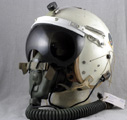
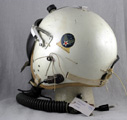
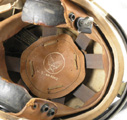
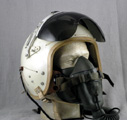
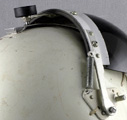
Far left: The main difference between the
P-4 and the P-4A is the visor. The P-4A visor featured a metal track
running from the frontal area to the crown of the helmet and rubber lock grip in the visor
yoke. Left: Due to the
visor track, the USAF label had to be moved to the side of the helmet. Middle:
The rubber edge beading on the
majority of the P-4A helmets had a square cross-section. Right: The P-4A
was the first P-series helmet type that
came in a size X-Large. Compared to the size small P-1A above the XL P-4A has a much more
round appearance.
Far right: J-arms were not necessary any longer on the P-4A visor yoke.
It was locked in UP-position when the
rubber lock grip metal pin engaged in the centre track lock recess. Pictures © Bluelight
P-4B
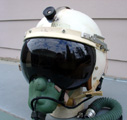
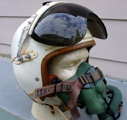
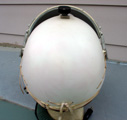
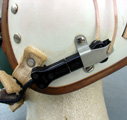
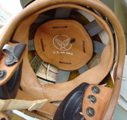
Far left: At first glance it is very easy
to mistake a P-4B for a P-4A. Left: P-4B was fitted with an updated type
of
headset, the H-149/AIC, which was attached much in the same way as the old HS-38A headset.
The external draw-
strings and headset attachment screws are therefore missing on the P-4B. Middle:
The H-149/AIC headset did
away with the pigtail communications cord. Right: The earlier rubber boot
was substituted by a metal bracket.
Far right: The P-4B saw a return to the rounded rubber edge beading.
Pictures © unknown